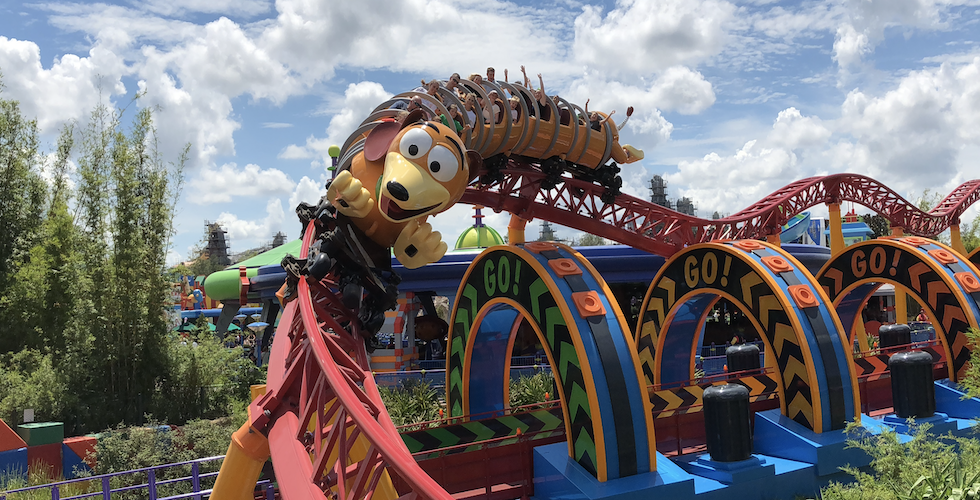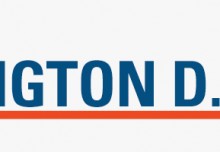Bob Sehlinger, coauthor of The Unofficial Guide to Walt Disney World, in a series of two articles, takes us on a tour of the different theme park rides. In today’s installment he focuses on roller coasters.
If you ever go to a party where guests are discussing Immelmanns, batwings, heartline rolls, dive-loops, rollovers, lift hills, and LIM launchers, don’t mistake the guests for fighter pilots. Incredibly, you will be among the intelligentsia of roller-coaster aficionados.

Coasters are the defining rides in most theme parks. Good roller coasters equal good theme parks—it’s as simple as that. Though non-coaster thrill rides often serve up a wilder ride experience, it’s the coasters that draw us in and fire our imagination. Show us the schoolboy who hasn’t sketched his own fantasy roller coaster while the teacher drones on.
Roller coasters are certainly thrill rides, but their evolution followed a very different path. They sprung from a popular fad in fifteenth-century Russia to replicate the excitement of sledging (i.e., riding a small platform or sleigh over ice and snow). In places where the natural topography was not conducive to sledging, artificial hills were constructed by piling up snow and ice. In the eighteenth century, the sledge courses escaped the grip of winter by the substitution of a wooden trestle for the frozen hill and by mounting wheels on the sledge. You hauled your sledge to the top of the trestle and, as they say, it was all downhill from there.

Interest in coasters, which western Europeans called “Russian Mountains,” waned after numerous injuries and fatalities. Though a small number of coasters, or “centrifugal railways,” were built in England and France in the 1800s, the genre was largely dormant until revived by LaMarcus Adna Thompson’s Switchback Railway at Coney Island, near New York City, in 1884. Thompson’s coaster, designed on the old Russian Mountain model, featured cars that rolled at 6 mph down a 600-foot undulating track from a starting elevation of 50 feet. In 1884 Charles Alcoke created the first coaster to make a complete circuit. The following year Phillip Hinkle introduced the concept of a “lift hill,” the initial hill on which the train was hauled to the highest elevation of the circuit on a cable and later by a chain-and-ratchet mechanism. The lift hill revolutionized coasters, allowing an expanded layout and the incorporation of an elliptical design into the course of the track.

Towards the middle of the nineteenth century, designers began to experiment with vertical loops. The first looping coaster was built in England and exported to Frascati Gardens in Paris, in 1846. Riders would descend a modest hill, from which their momentum would carry them through the loop and out the other side. The 1890s saw a renewed interest in loops, and several looping coasters were built. They were rough affairs, however, inflicting such serious whiplash on riders that most were taken out of service within a year.
All of the early roller coasters were made of wood. Turn-of-the-twentieth-century coasters sometimes carried a brakeman to slow a train’s speed around sharp turns. In 1912, John Miller from Homewood, Illinois, invented the under-friction coaster. For the first time, coasters were equipped with up-stop wheels that ran under the track to keep the train from jumping off. Miller also invented various new braking and passenger restraints. These inventions allowed coaster designers to incorporate high speeds, steep drops, and sharp horizontal and vertical curves. In short, they made modern roller coasters possible.

As you might expect, coasters bloomed like wildflowers, with John Miller and his partner designing 140 themselves. Thirteen examples of Miller’s work have survived, including a coaster at Lagoon outside Salt Lake City that is the sixth-oldest coaster in the world.
The Great Depression halted what was known as the first golden age of roller coasters. The coaster industry, incredibly, didn’t revive until 1972, when The Racer was constructed at King’s Island amusement park on the Ohio River close to Cincinnati, Ohio.
The first half of the twentieth century witnessed the increased use of steel to replace wood in coaster superstructure, but steel didn’t really come into its own in track design until 1959, when Disneyland, in California, opened the Matterhorn Bobsleds attraction. This was the first coaster to use a tubular steel track. Tubular steel can be bent in any direction. This led to breakthroughs in coaster design that made possible such ride elements as loops, corkscrews, various kinds of rolls and inversions, overbanked turns, and many other maneuvers that were previously impossible. The Matterhorn was also the first coaster to use individual brake zones, sections of the layout where a train’s speed could be adjusted. This innovation allowed for two or more trains to operate on the track simultaneously, thus increasing hourly capacity and cutting queuing times.

Though Disney pioneered the concept of super-coasters with the Matterhorn Bobsleds at Disneyland in 1959, it took them 16 years to add another roller coaster, Space Mountain at Walt Disney World, to their repertoire. In relatively quick succession followed Space Mountain at Disneyland and Big Thunder Mountain Railroad at both Disneyland and Walt Disney World’s Magic Kingdom. Irrespective of the popularity of the “mountains,” Disney didn’t build another coaster in the U.S. for almost 20 years. In the interim, coasters enjoyed a technical revolution that included aircraft carrier-type launching devices and previously unimaginable loops, corkscrews, vertical drops, and train speeds. Through all this, Disney sat on the sidelines. After all, Disney parks didn’t offer “rides,” but rather “adventure experiences,” where the sensation of the ride itself was always secondary to storyline and visuals.

Competition, however, has long been Disney’s alarm clock, and when archrival Universal announced plans for its Islands of Adventure theme park featuring an entire arsenal of thrill rides, Disney began to wake up. Today, Disney boasts a lineup of technically innovative (though not extremely intense) roller coasters, including the launched Slinky Dog Dash and the upcoming Guardians of the Galaxy indoor spinning coaster. Universal continues to match the Mouse with highly themed thrills of its own, like Hagrid’s Magical Creatures Motorbike Adventure (with backwards and drop tracks) and the upcoming Jurassic World VelociCoaster.

Types of Roller Coasters
Coasters operating today are made either of steel or of wood. Among both types are adult coasters, usually defined as coasters with a minimum height requirement of at least 40″ (1.01 m); and children’s coasters, smaller non-intimidating models designed to give younger children an introduction to the genre.
Most coasters are outdoors, but some are enclosed inside buildings. Disney’s Space Mountain was the first major indoor coaster that made use of its enclosure to project a space-travel theme. Modern indoor coasters, such as Universal’s Revenge of the Mummy, represent a combination of ghost train (dark ride) and roller coaster.

While modern wooden coasters are capable of loops and other sophisticated maneuvers, they are all essentially the same, consisting of a six- to eight-car train accommodating four persons per car, with the track beneath the train. In contrast, there are a number of different types of steel coasters:
Traditional Coasters
These are exactly like wooden coasters, with multi-car trains sitting atop the tracks.
Inverted Coasters
Here the train is suspended from an overhead track, leaving your feet to dangle in space as the coaster traces its circuit.

Flying Coasters
Once again the track is overhead. This time, however, you are rotated from a sitting position to a prone one, with your body parallel with the track, so you feel like you’re flying. Manta at Sea World Orlando is a flying coaster.
Launched (or Accelerator) Coasters
These coasters are launched up the first hill like jets off an aircraft carrier. Several technologies can be used, including linear-induction motors, which power the launch using electromagnetic propulsion, catapults, and hydraulic pumps that compress nitrogen. Launch speeds vary but can range up to 0–60 mph (0–96 km/h) in 3 seconds. The Incredible Hulk coaster at Islands of Adventure and Rock n’ Roller Coaster at Disney’s Hollywood Studios are good examples of this genre.

Bobsled Coasters
These are chain-pulled to the top of the lift hill and then released to roll down a half-pipe without tracks (think bobsled run). Matterhorn Bobselds at Disneyland is the iconic example of a bobsled coaster.
Diving Machines
The ride vehicle here has two rows of seats with six or eight riders per row. After climbing the lift hill, the car rolls to the edge of a near-vertical first drop and then hangs momentarily over the edge before being released to dive down and complete the circuit.

Floorless Coasters
In this version, the train cars are mounted several feet above the track. After you board, the loading platform (the floor) drops away, leaving your feet dangling. Sheikra at Busch Gardens Tampa is both a diving machine and floorless coaster.

Mine Trains
Usually, but not always, these small coasters, frequently with both and indoor and outdoor segments, are characterized by tight-banked turns and short, steep drops. Based on the concept of a runaway mine train, theming is occasionally very elaborate, as with Disney’s Big Thunder Mountain Railroad.

You’re probably getting the drift that there’s a whole vocabulary of roller-coaster jargon (for the record, we haven’t even scratched the surface). If you want to impress your friends at dinner parties, you can bone up on coaster terminology at Ultimate Roller Coaster or on this website.
Coaster Problems: Whiplash and Nausea
As a generalization, steel coasters offer a smoother ride than do wooden coasters, which are infamous for side-to-side jarring. The stress on the moving and structural parts of a roller coaster is immense. Consequently, the ride becomes rougher on both steel and wooden coasters as they age. It’s very possible, sometimes even likely, to sustain neck, back, and head injuries on a roller coaster (as well as on other thrill rides). To mitigate whiplash and other insults to the cervical vertebrae, the Los Angeles Decompression Therapy website recommends the following:

“The way to lessen the likelihood of cervical trauma [on a roller coaster] is to look at where the next turn is and be ready for it. Being prepared means paying attention to what is going on. When going down a large slope, look at what is next; if there is a turn to the left, get ready for it. The brain can communicate with the muscles to get ready for the turn. Some of the most damaging injuries to the ligaments and discs in the neck happen when a person is not ready for it. They are caught off-guard, the muscles are relaxed, and there is no defense to the trauma. Roller-coaster rides are fun and should be enjoyed; just pay attention while [riding] and keep your neck healthy.”
As an addendum, you’re likely to be more off-guard at the start or end of a ride than during the ride itself. We’ve experienced our most serious jarring when the coaster train violently lurched from the loading station and then again when it suddenly braked to a stop before re-entering the station. The severity of the movement in both cases was very much unexpected.
If you’re prone to motion sickness, we can think of better places for you to be than on a roller coaster. But if, like many of us, nausea takes you by surprise while you ride, here are some dos and don’ts:
• Do eat something before riding—riding on an empty stomach is just asking for it.
• Don’t ride with your eyes closed.
• Concentrate your gaze on a single fixed object if you begin to feel sick.
Read Bob’s installment about the evolution of non-coaster thrill rides here.
If you enjoyed this post, please subscribe to our YouTube channel and sign up for our newsletter here. Be sure to follow us on Twitter, Facebook, Instagram, and YouTube.




